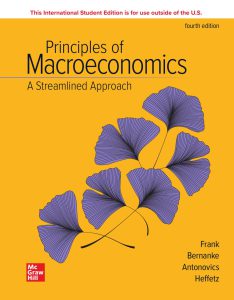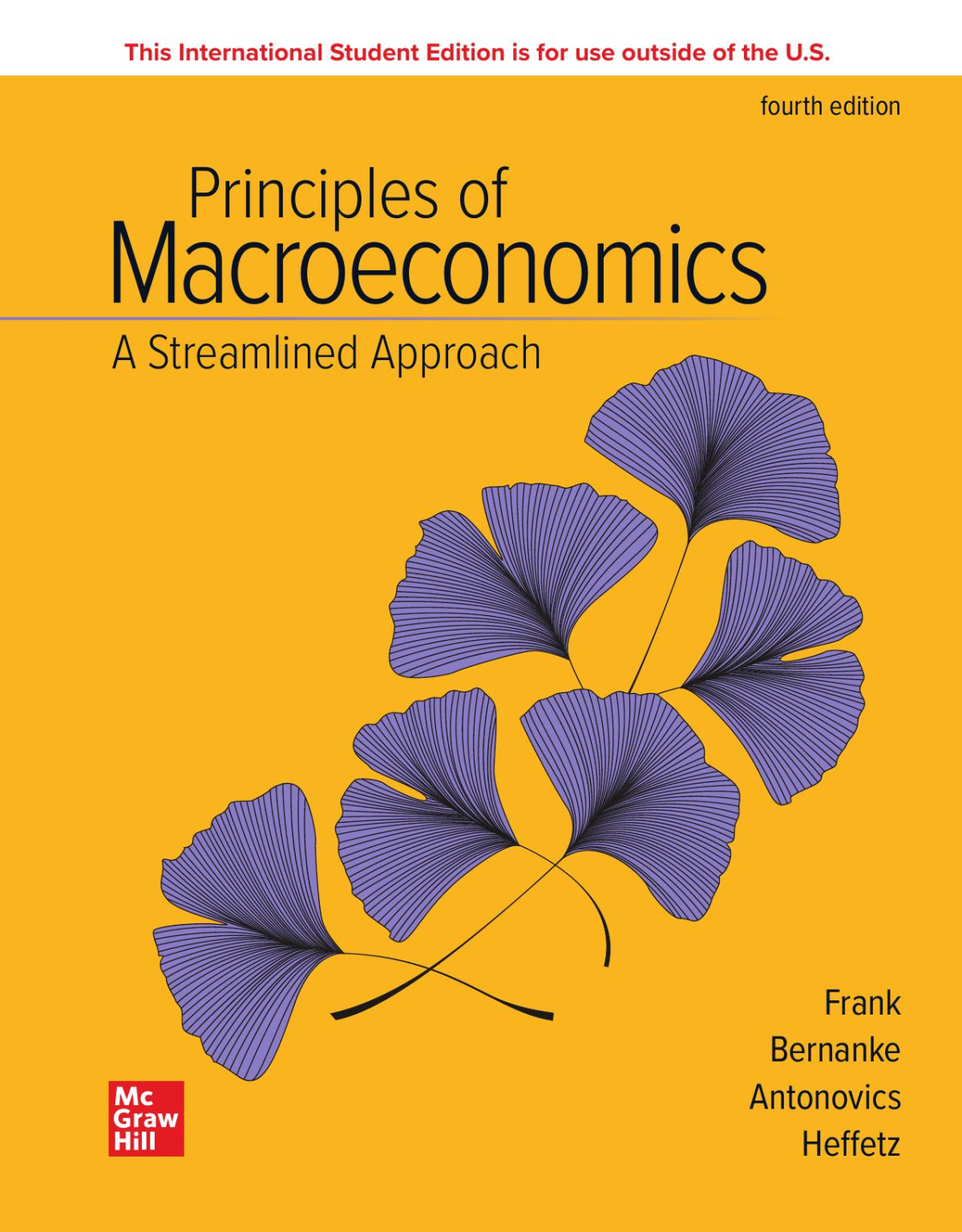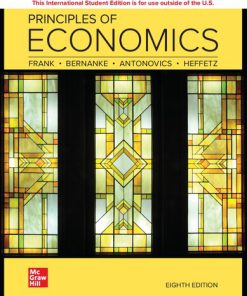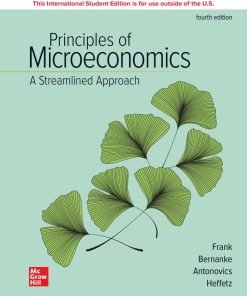Principles of Macroeconomics: A Streamlined Approach, 4e ISE by Robert 9781264058648 1264058640
$50.00 Original price was: $50.00.$25.00Current price is: $25.00.
Principles of Macroeconomics: A Streamlined Approach, 4e ISE Robert H. Frank – Ebook Instant Download/Delivery ISBN(s): 9781264058648, 1264058640

Product details:
- ISBN 10:1264058640
- ISBN 13:9781264058648
- Author: Robert
Principles of Economics, A Streamlined Approach
Table contents:
Chapter 1 Thinking Like an Economist
Economics: Studying Choice in a World of Scarcity
Applying the Cost-Benefit Principle
Economic Surplus
Opportunity Cost
The Role of Economic Models
Three Important Decision Pitfalls
Pitfall 1: Measuring Costs and Benefits as Proportions Rather than Absolute Dollar Amounts
Pitfall 2: Ignoring Implicit Costs
Pitfall 3: Failing to Think at the Margin
Normative Economics versus Positive Economics
Economics: Micro and Macro
The Approach of This Text
Economic Naturalism
THE ECONOMIC NATURALIST 1.1
THE ECONOMIC NATURALIST 1.2
THE ECONOMIC NATURALIST 1.3
Summary
Key Terms
Review Questions
Problems
Answers to Self-tests
Appendix: Working with Equations, Graphs, and Tables
Chapter 2 Supply and Demand
What, How, and for Whom? Central Planning versus the Market
Buyers and Sellers in Markets
The Demand Curve
The Supply Curve
Market Equilibrium
Rent Controls Reconsidered
Pizza Price Controls?
Predicting and Explaining Changes in Prices and Quantities
Shifts in Demand
THE ECONOMIC NATURALIST 2.1
Shifts in the Supply Curve
THE ECONOMIC NATURALIST 2.2
Four Simple Rules
THE ECONOMIC NATURALIST 2.3
Efficiency and Equilibrium
Cash on the Table
Smart for One, Dumb for All
THE ECONOMIC NATURALIST 2.4
Summary
Key Terms
Review Questions
Problems
Answers to Self-tests
Appendix: The Algebra of Supply and Demand
Chapter 3 Demand and Elasticity
The Law of Demand
The Origins of Demand
Needs versus Wants
THE ECONOMIC NATURALIST 3.1
Applying the Law of Demand
Substitution at Work
THE ECONOMIC NATURALIST 3.2
THE ECONOMIC NATURALIST 3.3
THE ECONOMIC NATURALIST 3.4
The Importance of Income Differences
THE ECONOMIC NATURALIST 3.5
Individual and Market Demand Curves
Horizontal Addition
Elasticity
Price Elasticity of Demand
Price Elasticity Defined
Determinants of Price Elasticity of Demand
some representative elasticity estimates
Using Price Elasticity of Demand
The Economic Naturalist 3.6
The Economic Naturalist 3.7
A Graphical Interpretation of Price Elasticity
Price Elasticity Changes along a Straight-Line Demand Curve
Two Special Cases
Elasticity and Total Expenditure
Income Elasticity and Cross-Price Elasticity of Demand
Summary
Key Terms
Review Questions
Problems
Answers to Self-tests
Chapter 4 Perfectly Competitive Supply
Thinking about Supply: The Importance ofOpportunity Cost
Individual and Market Supply Curves
Profit-Maximizing Firms in Perfectly Competitive Markets 95
Profit Maximization
The Demand Curve Facing a Perfectly Competitive Firm
Production in the Short Run
Choosing Output to Maximize Profit
Price Equals Marginal Cost: The Seller’s Supply Rule
Graphing Marginal Cost
The “Law” of Supply
Applying the Theory of Supply
The Economic Naturalist 4.
Determinants of Supply Revisited
Technology
Input Prices
The Number of Suppliers
Expectations
Changes in Prices of Other Products
The Price Elasticity of Supply
Determinants of Supply Elasticity
The Economic Naturalist 4.2
Unique and Essential Inputs: The Ultimate Supply Bottleneck
Summary
Key Terms
Review Questions
Problems
Answers to Self-tests
Chapter 5 Efficiency, Exchange, and the Invisible Hand in Action
The Central Role of Economic Profit
Three Types of Profit
The Invisible Hand Theory
Two Functions of Price
Responses to Profits and Losses
The Effect of Market Forces on Economic Profit
The Importance of Free Entry and Exit
The Invisible Hand in Action
The Economic Naturalist 5.
Economic Rent versus Economic Profit
The Distinction between an Equilibrium and a Social Optimum
Smart for One, Dumb for All
The Economic Naturalist 5.2
Market Equilibrium and Efficiency
The Cost of Preventing Price Adjustments
Summary
Key Terms
Review Questions
Problems
Answers to Self-tests
Chapter 6 Monopoly, Oligopoly, and Monopolistic Competition
Perfect and Imperfect Competition
Different forms of Imperfect Competition
The Essential Difference between Perfectly and Imperfectly Competitive Firms
Five Sources of Market Power
Exclusive Control over Important Inputs
Patents and Copyrights
Government Licenses or Franchises
Economies of Scale and Natural Monopolies
Network Economies
Economies of scale and the importance of start-Up costs
The Economic Naturalist 6.
Profit Maximization for the Monopolist
Marginal Revenue for the Monopolist
The Monopolist’s Profit-Maximizing Decision Rule
Being a Monopolist Doesn’t Guarantee an Economic Profit
Why the Invisible Hand Breaks Down underMonopoly
Using Discounts to Expand the Market
Price Discrimination Defined
The Economic Naturalist 6.2
How Price Discrimination Affects Output
The Hurdle Method of Price Discrimination
Is Price Discrimination a Bad Thing?
Examples of Price Discrimination
The Economic Naturalist 6.
Summary
Key Terms
Review Questions
Problems
Answers to Self-tests
Chapter 7 Games and Strategic Behavior
Using Game Theory to Analyze Strategic Decisions
The Three Elements of a Game
Nash Equilibrium
The Prisoner’s Dilemma
The Original Prisoner’s Dilemma
The Economics of Cartels
The Economic Naturalist 7.1
Tit-for-Tat and the Repeated Prisoner’s Dilemma
The Economic Naturalist 7.
The Economic Naturalist 7.
Games in Which Timing Matters
Credible Threats and Promises
Monopolistic Competition When Location Matters
The Economic Naturalist 7.
Commitment Problems
Solving Commitment Problems with Psychological Incentives
Summary
Key Terms
Review Questions
Problems
Answers to Self-tests
Chapter 8 An Introduction to Behavioral Economics
Judgmental Heuristics or Rules of Thumb
Availability
Representativeness
Regression to the Mean
The Economic Naturalist 8.1
Anchoring and Adjustment
Misinterpretation of Contextual Clues
The Psychophysics of Perception
The Difficulty of Actually Deciding
Impulse-Control Problems
The Economic Naturalist 8.
Loss Aversion and Status Quo Bias
The Economic Naturalist 8.
Concerns about Relative Position
The Economic Naturalist 8.
The Economic Naturalist 8.
Summary
Key Terms
Review Questions
Problems
Answers to Self-tests
Chapter 9 Externalities and Property Rights
External Costs and Benefits
How Externalities Affect Resource Allocation
The Coase Theorem
Remedies for Externalities
Laws and Regulations
The Economic Naturalist 9.1
The Optimal Amount of Negative Externalities Is Not Zero
Compensatory Taxes and Subsidies
The Economic Naturalist 9.
Property Rights and the Tragedy of the Commons
The Problem of Unpriced Resources
The Effect of Private Ownership
When Private Ownership Is Impractical
The Economic Naturalist 9.
The Economic Naturalist 9.
Positional Externalities
Payoffs That Depend on Relative Performance
The Economic Naturalist 9.5
Positional Arms Races and Positional Arms Control Agreements
Social Norms as Positional Arms Control Agreements
Summary
Key Terms
Review Questions
Problems
Answers to Self-tests
Chapter 10 Using Economics to Make Better Policy Choices
The Economics of Health Care
The Case for Mandatory Immunization Laws
Explaining Rising Health Care Costs
Designing a Solution
The HMO Revolution
The Economic Naturalist 10.1
The Problem with Health Care Provision through Private Insurance
The Affordable Care Act of
Using Price Incentives in Environmental Regulation
Taxing Pollution
Auctioning Pollution Permits
Climate Change and Carbon Taxes
Methods of Income Redistribution
Welfare Payments and In-Kind Transfers
Means-Tested Benefit Programs
The Negative Income Tax
Minimum Wages
The Earned-Income Tax Credit
Public Employment for the Poor
A Combination of Methods
Summary
Key Terms
Review Questions
Problems
Answers to Self-tests
Chapter 11 International Trade and Trade Policy
Comparative Advantage as a Basis for Trade
A Supply and Demand Perspective on Trade
Winners and Losers from Trade
The Economic Naturalist 11.
Protectionist policies: tariffs and quotas
Tariffs
Quotas
The Economic Naturalist 11.2
The Inefficiency of Protectionism
The Economic Naturalist 11.
Summary
Key Terms
Review Questions
Problems
Answers to Self-tests
Chapter 12 Macroeconomics: The Bird’s-Eye View of the Economy
The Major Macroeconomic Issues
Economic Growth and Living Standards
Productivity
Recessions and Expansions
Unemployment
Inflation
Economic Interdependence among Nations
Macroeconomic Policy
Types of Macroeconomic Policy
Positive versus Normative Analyses of Macroeconomic Policy
Aggregation
Studying Macroeconomics: A Preview
Summary
Key Terms
Review Questions
Problems
Answers to Self-tests
Chapter 13 Measuring Economic Activity: GDP, Unemployment, and Inflation
Gross Domestic Product: Measuring the Nation’s Output
Market Value
Final Goods and Services
Produced in a Country during a Given Period
Methods for Measuring GDP 307
The Expenditure Method for Measuring GDP
GDP and the Incomes of Capital and Labor
Nominal GDP versus Real GDP
The Economic Naturalist 13.1
Real Gdp, Economic Growth, and Economic Well-Being
Unemployment and the Unemployment Rate
Measuring Unemployment
The Costs of Unemployment
The Duration of Unemployment
The Unemployment Rate versus “True” Unemployment
The Consumer Price Index and Inflation 320
Inflation
Adjusting for Inflation
Deflating a Nominal Quantity
Indexing to Maintain Buying Power
The Economic Naturalist 13.
Inflation Measurement and Quality Change
The Costs of Inflation: Not What You Think
The True Costs of Inflation
Summary
Key Terms
Review Questions
Problems
Answers to Self-tests
Chapter 14 Economic Growth, Productivity, and Living Standards
The Remarkable Rise in Living Standards: The Record
Why “Small” Differences in Growth Rates Matter
Why Nations Become Rich: The Crucial Role of Average Labor Productivity
The Determinants of Average Labor Productivity
Human Capital
The Economic Naturalist 14.1
Physical Capital
Land and Other Natural Resources
Technology
The Economic Naturalist 14.2
Entrepreneurship and Management
The Economic Naturalist 14.3
The Political and Legal Environment
Real Gdp and Economic Well-Being 357
Why Real gdp Isn’t the Same as Economic Well-Being
The Economic Naturalist 14.4
But Gdp Is Related to Economic Well-Being
The Economic Naturalist 14.
Promoting Economic Growth
Policies to Increase Human Capital
The Economic Naturalist 14.6
Policies That Promote Saving and Investment
Policies That Support Research and Development
The Legal and Political Framework
The Poorest Countries: A Special Case?
Are There Limits to Growth?
Summary
Key Terms
Review Questions
Problems
Answers to Self-tests
Chapter 15 The Labor Market: Workers, Wages, and Unemployment
Five Important Labor Market Trends
Trends in Real Wages
Trends in Employment and Unemployment
Supply and Demand in the Labor Market 376
Wages and the Demand for Labor
Shifts in the Demand for Labor
The Economic Naturalist 15.1
The Supply of Labor
Shifts in the Supply of Labor
Explaining the Trends in Real Wages and Employment
Large Increases in Real Wages in Industrialized Countries
Real Wage Growth in the United States Has Stagnated since the Early 1970s, While Employment Growth Has Been Rapid
Increasing Wage Inequality: The Effects of Globalization and Technological Change
The Economic Naturalist 15.
Unemployment
Types of Unemployment and Their Costs
Impediments to Full Employment
Summary
Key Terms
Review Questions
Problems
Answers to Self-tests
Chapter 16 Saving and Capital Formation
Saving and Wealth
Stocks and Flows
Capital Gains and Losses
The Economic Naturalist 16.
The Economic Naturalist 16.
Why Do People Save?
The Economic Naturalist 16.3
Saving and the Real Interest Rate
Saving, Self-Control, and Demonstration Effects
The Economic Naturalist 16.
National Saving and Its Components
The Measurement of National Saving
Private and Public Components of National Saving
Public Saving and the Government Budget
Is Low Household Saving a Problem?
Investment and Capital Formation
Saving, Investment, and Financial Markets
The Economic Naturalist 16.
Summary
Key Terms
Review Questions
Problems
Answers to Self-tests
Chapter 17 Money, the Federal Reserve, and Global Financial Markets
Money and its Uses
The Economic Naturalist 17.1
Measuring Money
Commercial Banks and the Creation of Money
The Money Supply with Both Currency and Deposits
The Federal Reserve System 444
The History and Structure of the Federal Reserve System
Controlling the Money Supply: Open-Market Operations
The Fed’s Role in Stabilizing Financial Markets: Banking Panics
The Economic Naturalist 17.
The Financial System and the Allocation of Saving to Productive Uses
The Banking System
The Economic Naturalist 17.3
Bonds and Stocks
Bond Markets, Stock Markets, and the Allocation of Savings
The Informational Role of Bond and Stock Markets
Risk Sharing and Diversification
The Economic Naturalist 17.
International Capital Flows
Capital Flows and the Balance of Trade
The Determinants of International Capital Flows
Saving, Investment, and Capital Inflows
The Saving Rate and the Trade Deficit
The Economic Naturalist 17.
Summary
Key Terms
Review Questions
Problems
Answers to Self-tests
Chapter 18 Short-Term Economic Fluctuations and Fiscal Policy
The Economic Naturalist 18.
Recessions and Expansions
The Economic Naturalist 18.2
Some Facts about Short-Term Economic Fluctuations
Output Gaps and Cyclical Unemployment
Potential Output
The Output Gap
The Natural Rate of Unemployment and Cyclical Unemployment
The Economic Naturalist 18.
Why Do Short-Term Fluctuations Occur? A Preview and a Tale
Alice’s Ice Cream Store: A Tale about Short-Run Fluctuations
Recessions and Proposed Solutions: Keynes’s Analysis
The Keynesian Model’s Crucial Assumption: Firms Meet Demand at Preset Prices
The Economic Naturalist 18.4
Aggregate Output and Spending
Hey Big Spender! Consumer Spending and the Economy
The Multiplier
Stabilizing Spending: The Role of Fiscal Policy
Government Purchases and Spending
THE ECONOMIC NATURALIST 18.5
Taxes, Transfers, and Aggregate Spending
The Economic Naturalist 18.
Fiscal Policy as a Stabilization Tool: Three Qualifications
Fiscal Policy and the Supply Side
The Problem of Deficits
The Relative Inflexibility of Fiscal Policy
Summary
Key Terms
Review Questions
Problems
Answers to Self-tests
Chapter 19 Stabilizing the Economy: The Role of the Fed
The Federal Reserve and Interest Rates: The Basic Model
The Demand for Money
Macroeconomic Factors That Affect the Demand for Money
The Money Demand Curve
The Economic Naturalist 19.1
The Supply of Money and Money Market Equilibrium
How the Fed Controls the Nominal Interest Rate
The Role of the Federal Funds Rate in Monetary Policy
Can the Fed Control the Real Interest Rate?
The Federal Reserve and Interest Rates: A Closer Look
Can the Fed Fully Control the Money Supply?
Do Interest Rates Always Move Together?
The Effects of Federal Reserve Actions on the Economy
Aggregate Expenditure and the Real Interest Rate
The Fed Fights a Recession
The Economic Naturalist 19.2
The Fed Fights Inflation
The Economic Naturalist 19.
The Economic Naturalist 19.
The Economic Naturalist 19.5
The Fed’s Policy Reaction Function
The Economic Naturalist 19.
Monetary Policymaking: Art or Science?
Summary
Key Terms
Review Questions
Problems
Answers to Self-tests
Chapter 20 Aggregate Demand, Aggregate Supply, and Inflation
Inflation, Spending, and Output: The Aggregate Demand Curve
Inflation, the Fed, and Why the AD Curve Slopes Downward
Other Reasons for the Downward Slope of the AD Curve
Factors That Shift the Aggregate Demand Curve
Shifts of the AD Curve versus Movements along the AD Curve
Inflation and Aggregate Supply
Inflation Inertia
The Output Gap and Inflation
The Aggregate Demand–Aggregate Supply Diagram
The Self-Correcting Economy
Sources of Inflation 560
Excessive Aggregate Spending
The Economic Naturalist 20.1
Inflation Shocks
The Economic Naturalist 20.2
Shocks to Potential Output
The Economic Naturalist 20.3
Controlling Inflation
The Economic Naturalist 20.
The Economic Naturalist 20.
Summary
Key Terms
Review Questions
Problems
Answers to Self-tests
Chapter 21 Exchange Rates and the Open Economy
Exchange Rates
Nominal Exchange Rates
Flexible versus Fixed Exchange Rates
The Real Exchange Rate
The Economic Naturalist 21.
The Determination of the Exchange Rate in the Long Run 587
A Simple Theory of Exchange Rates: Purchasing Power Parity (PPP)
Shortcomings of the PPP Theory
The Determination of the Exchange Rate in the Short Run
The Foreign Exchange Market: A Supply and Demand Analysis
Changes in the Supply of Dollars
Changes in the Demand for Dollars
The Economic Naturalist 21.
Monetary Policy and the Exchange Rate
The Economic Naturalist 21.3
The Exchange Rate as a Tool of Monetary Policy
Fixed Exchange Rates 597
How to Fix an Exchange Rate
Speculative Attacks
Monetary Policy and the Fixed Exchange Rate
The Economic Naturalist 21.
The Economic Naturalist 21.
The Economic Naturalist 21.
Should Exchange Rates Be Fixed or Flexible?
The Economic Naturalist 21.
Summary
Key Terms
Review Questions
Problems
Answers to Self-tests
Glossary
Index
People also search:
principles of macroeconomics pdf
principles of macroeconomics 10th edition
principles of macroeconomics 10th edition pdf
principles of macroeconomics 9th edition
principles of macroeconomics stevenson and wolfers pdf
You may also like…
Computers - Information Systems
Business & Economics - Economics
Business & Economics - Sales & Marketing
Marketing Management 4th editon by Greg Marshall ISBN 1264155417 9781264155415
Biology and other natural sciences - Biology
ISE Principles of Biology 3rd Edition by Robert Brooker 9781260571325 1260571327
Business & Economics - Economics
Business & Economics - Economics
Principles of Microeconomics: A Streamlined Approach, 4e ISE Robert H. Frank
Business & Economics - Economics
Principles of Economics, A Streamlined Approach, 4e ISE Robert H. Frank
Medicine - Anatomy and physiology
Netter Atlas of Human Anatomy: 8th edition A Systems Approach Frank H. Netter Md
Business & Economics - Economics












